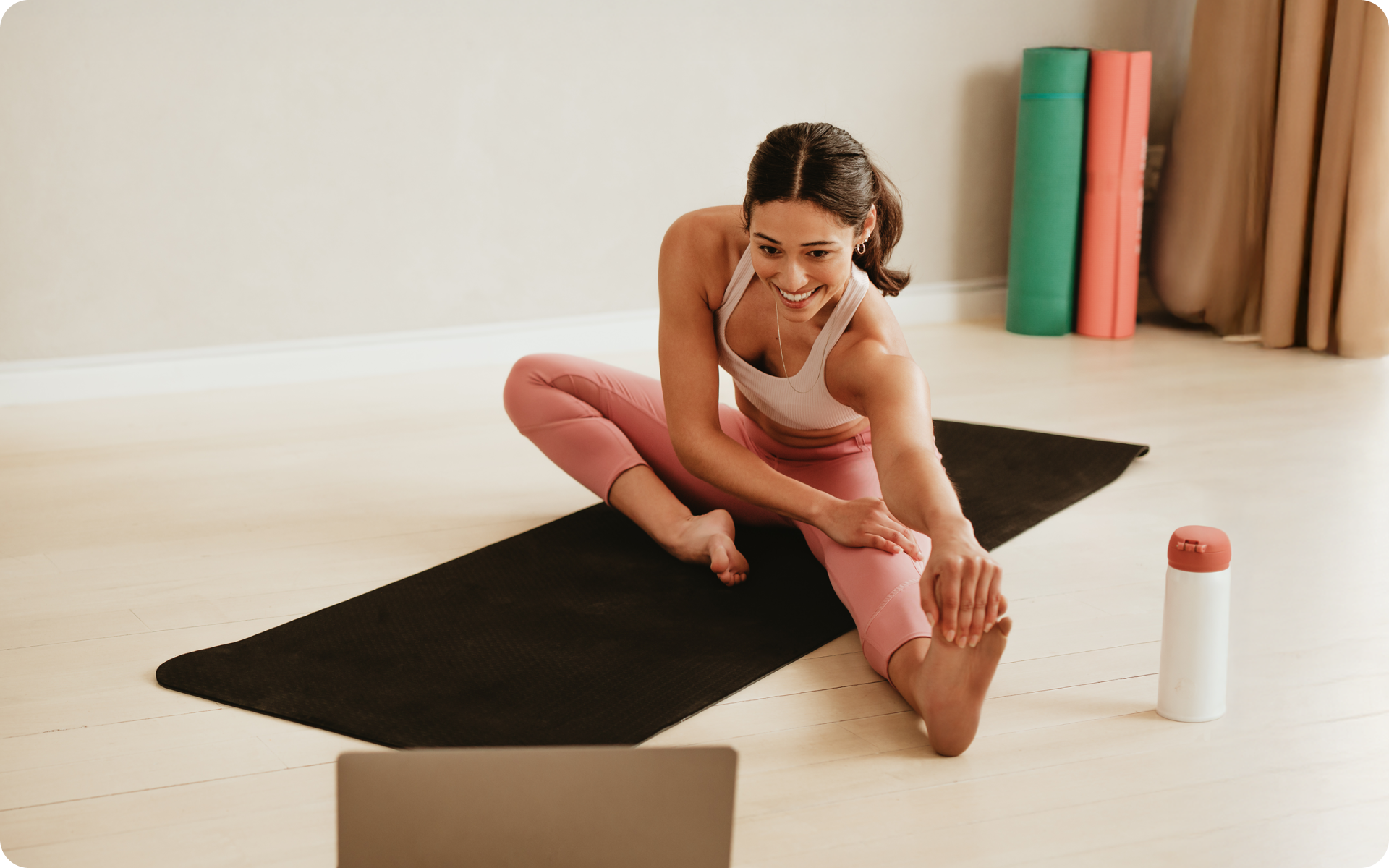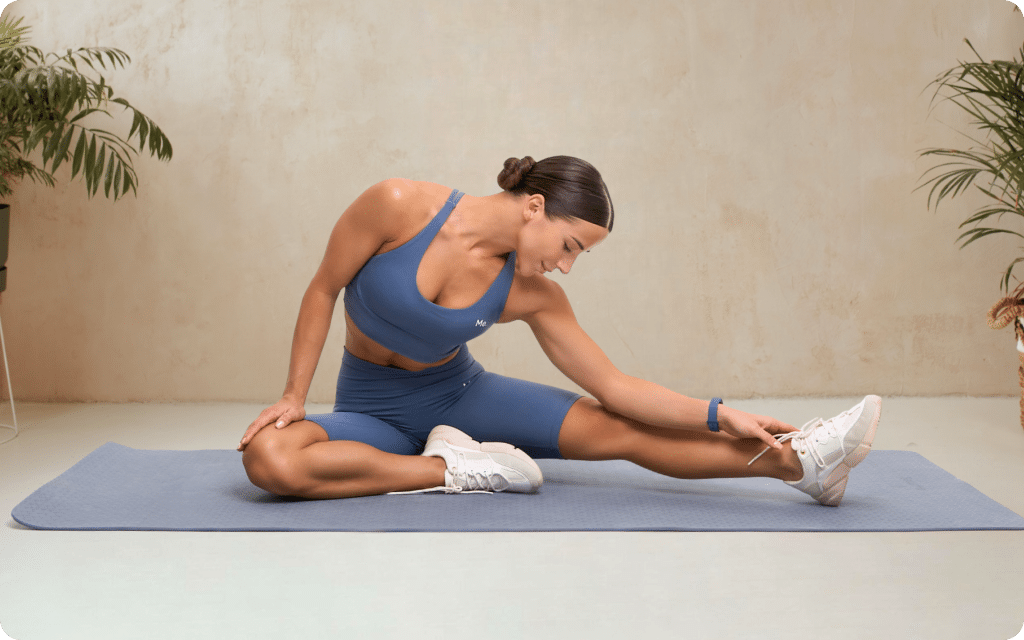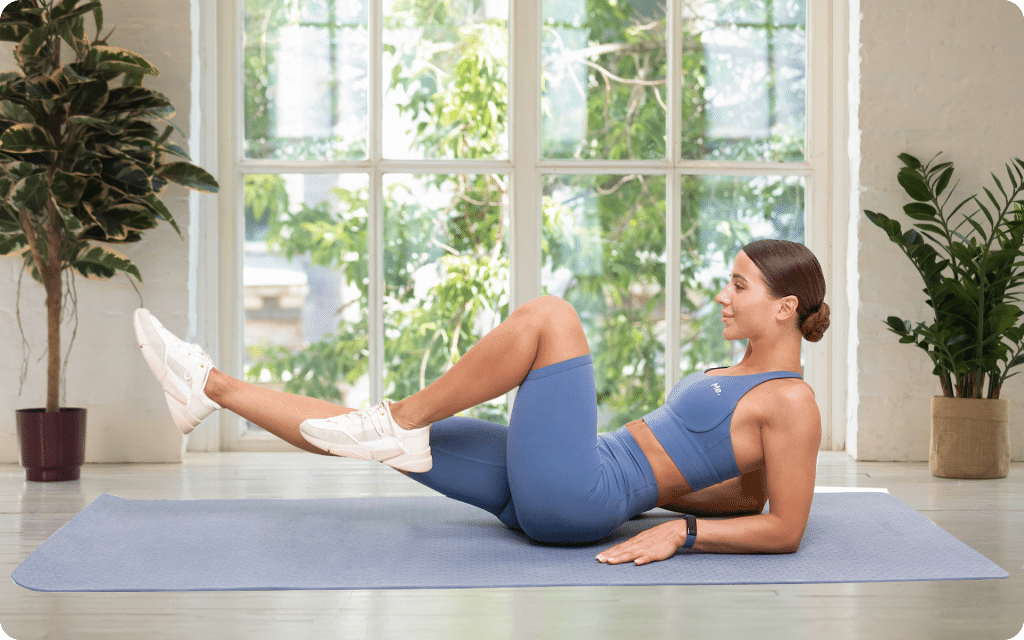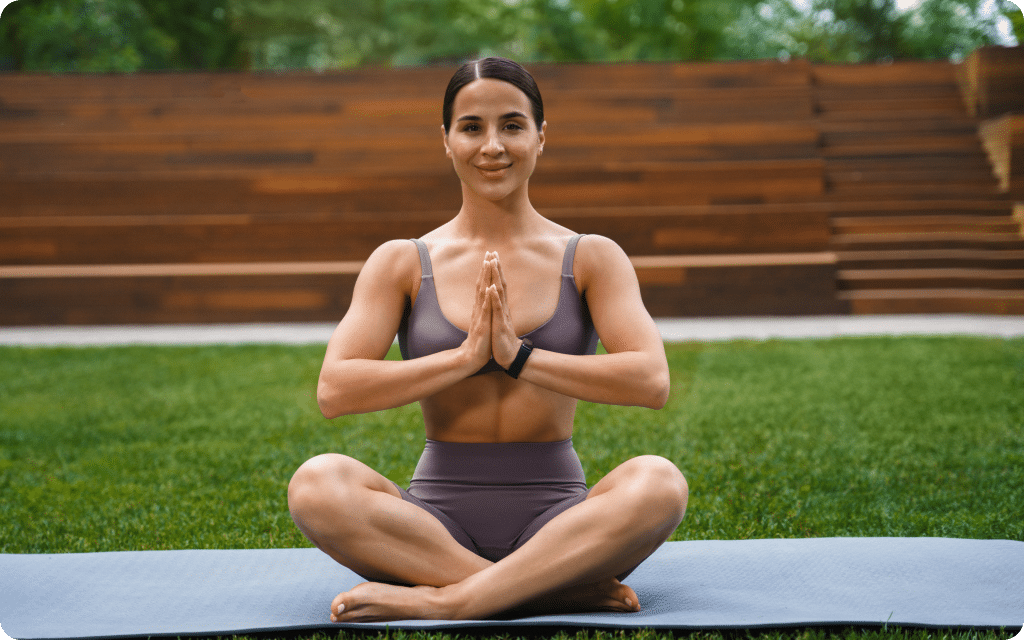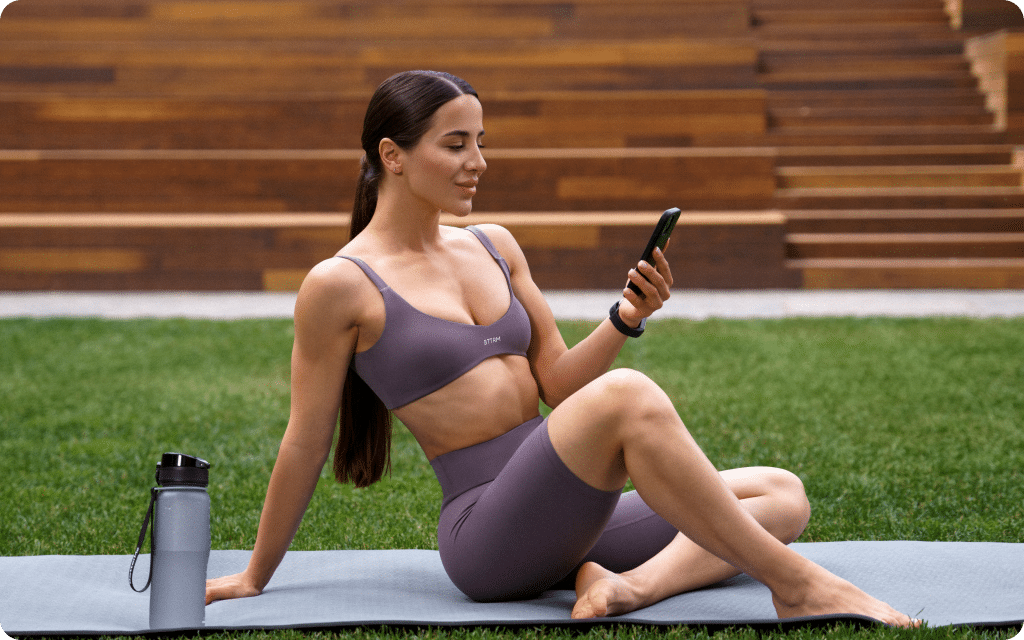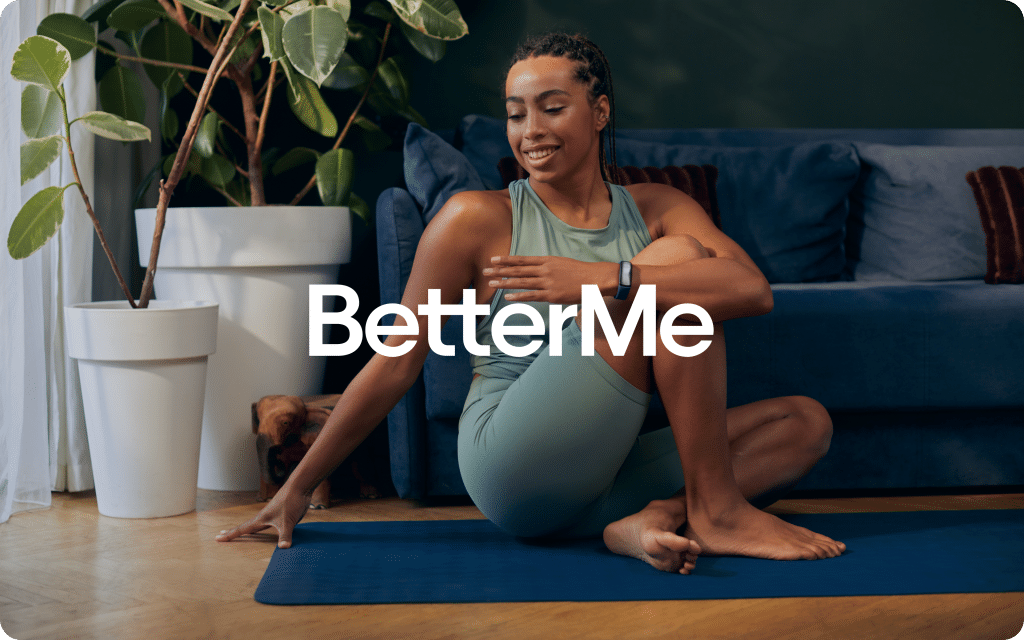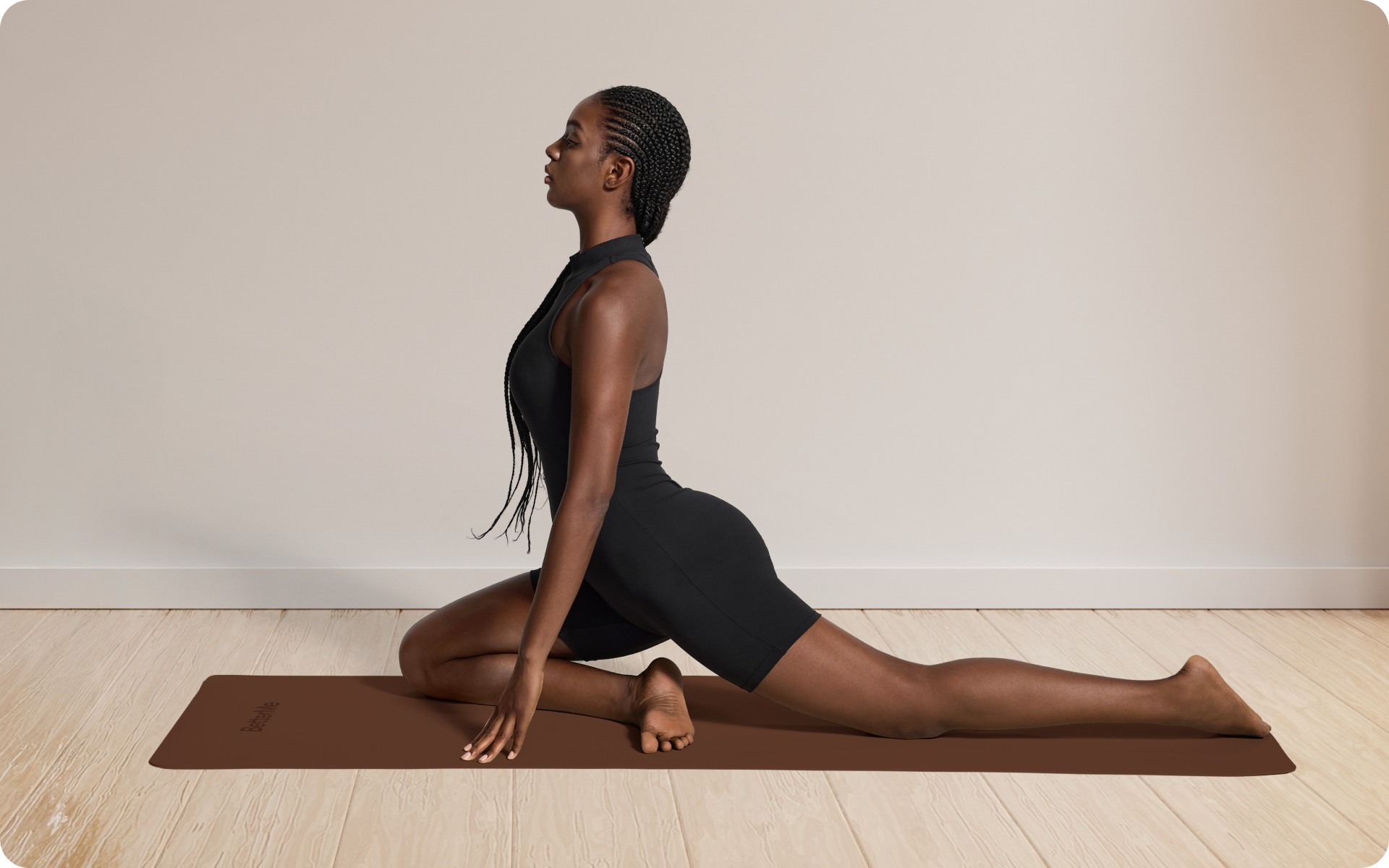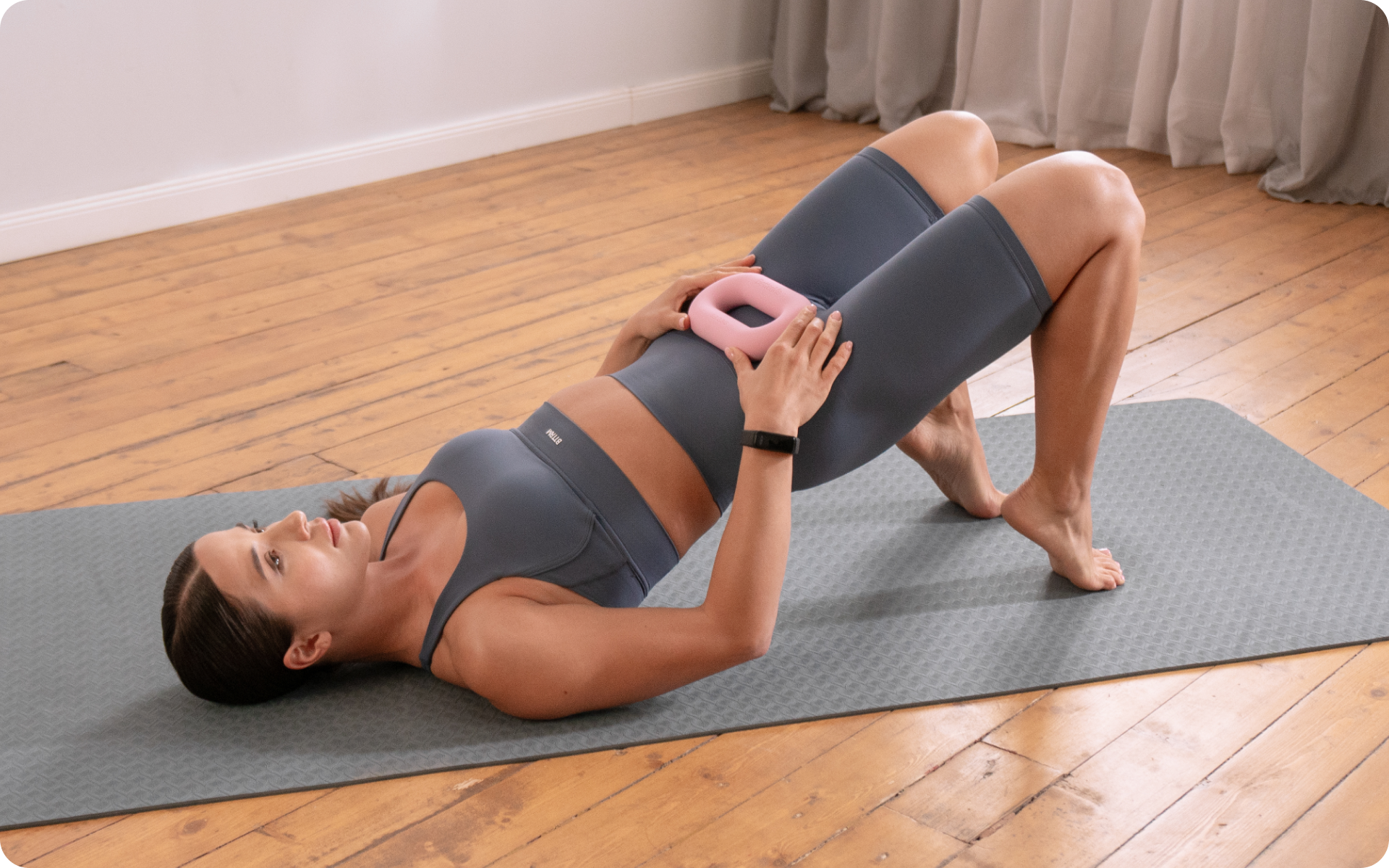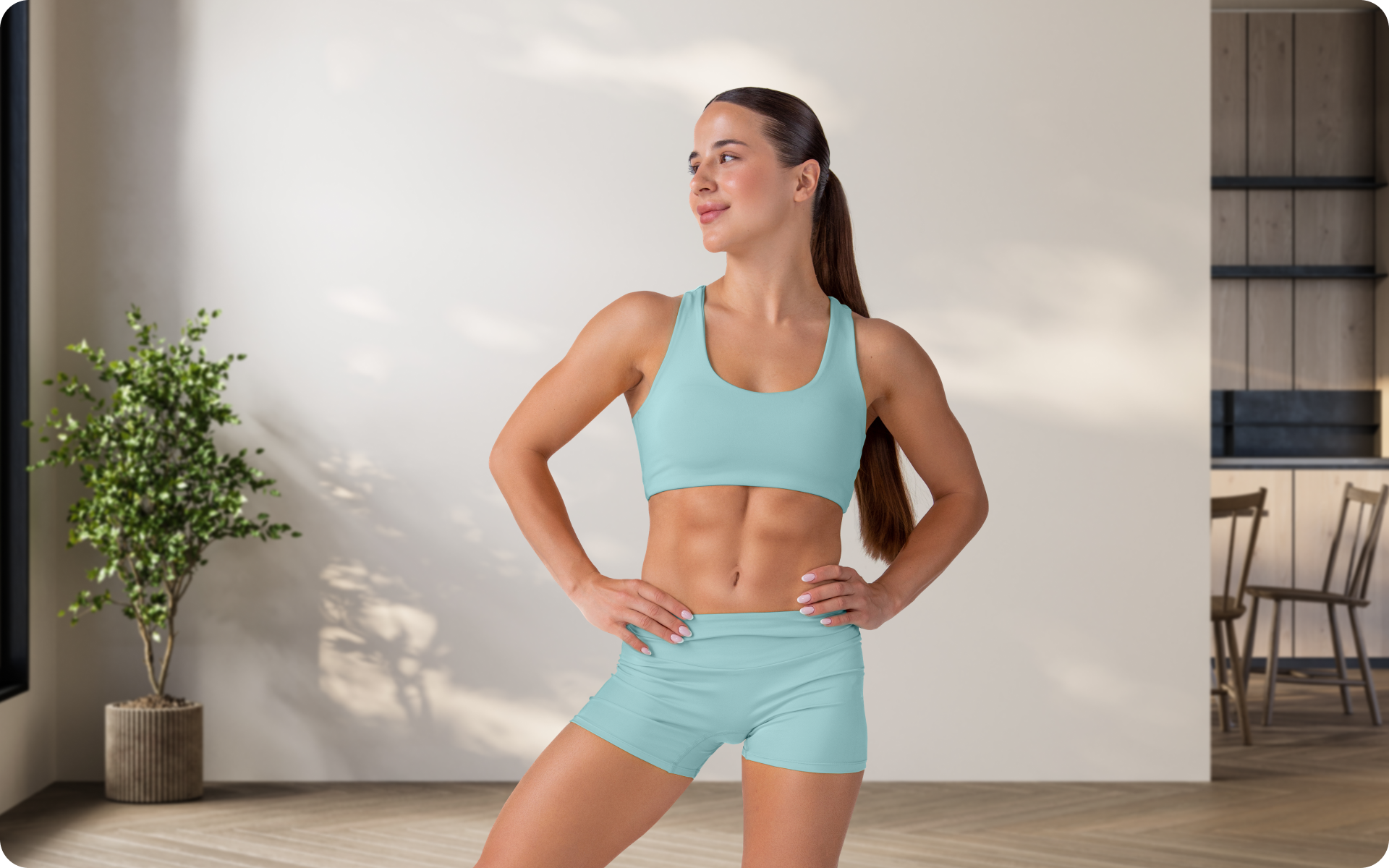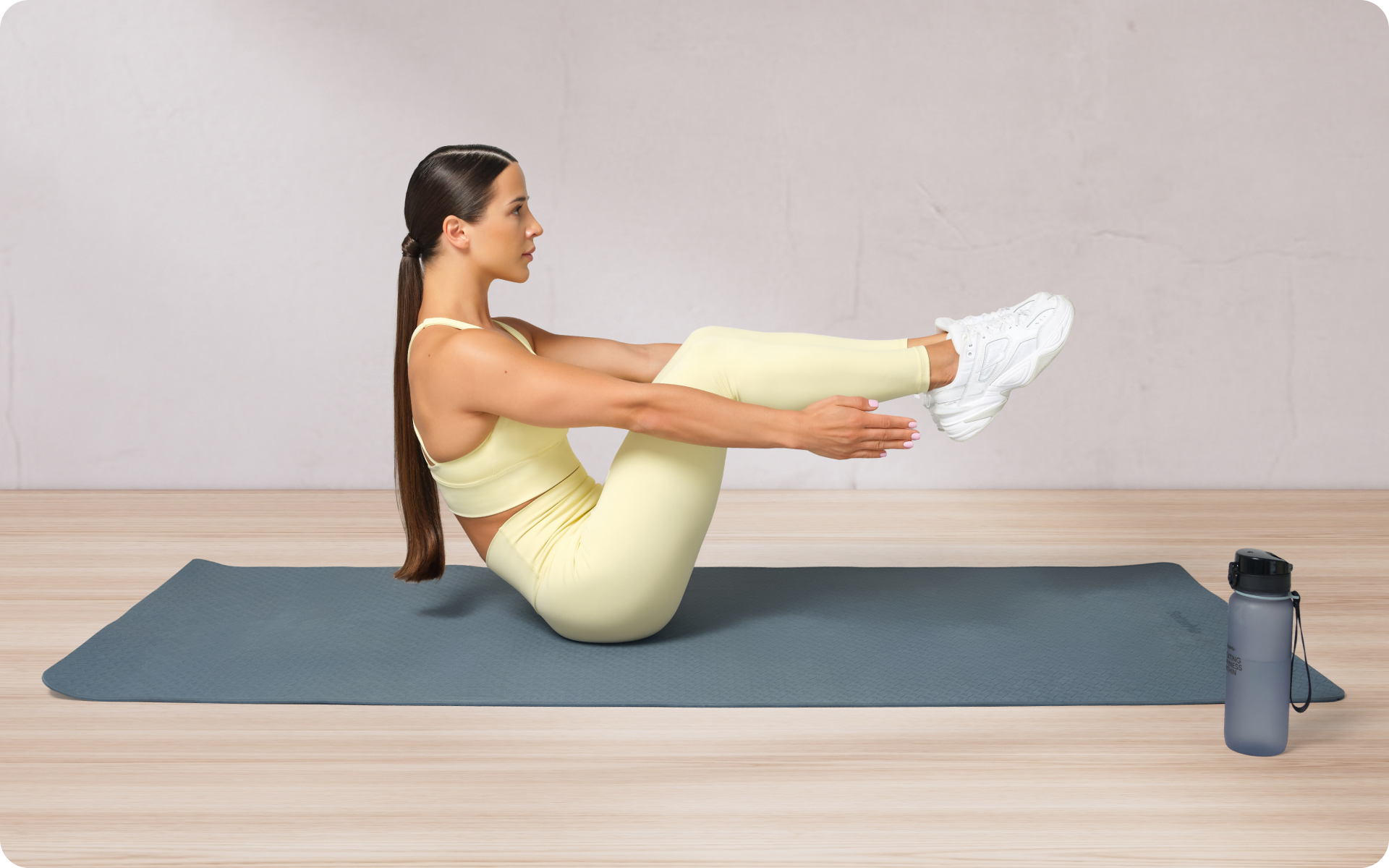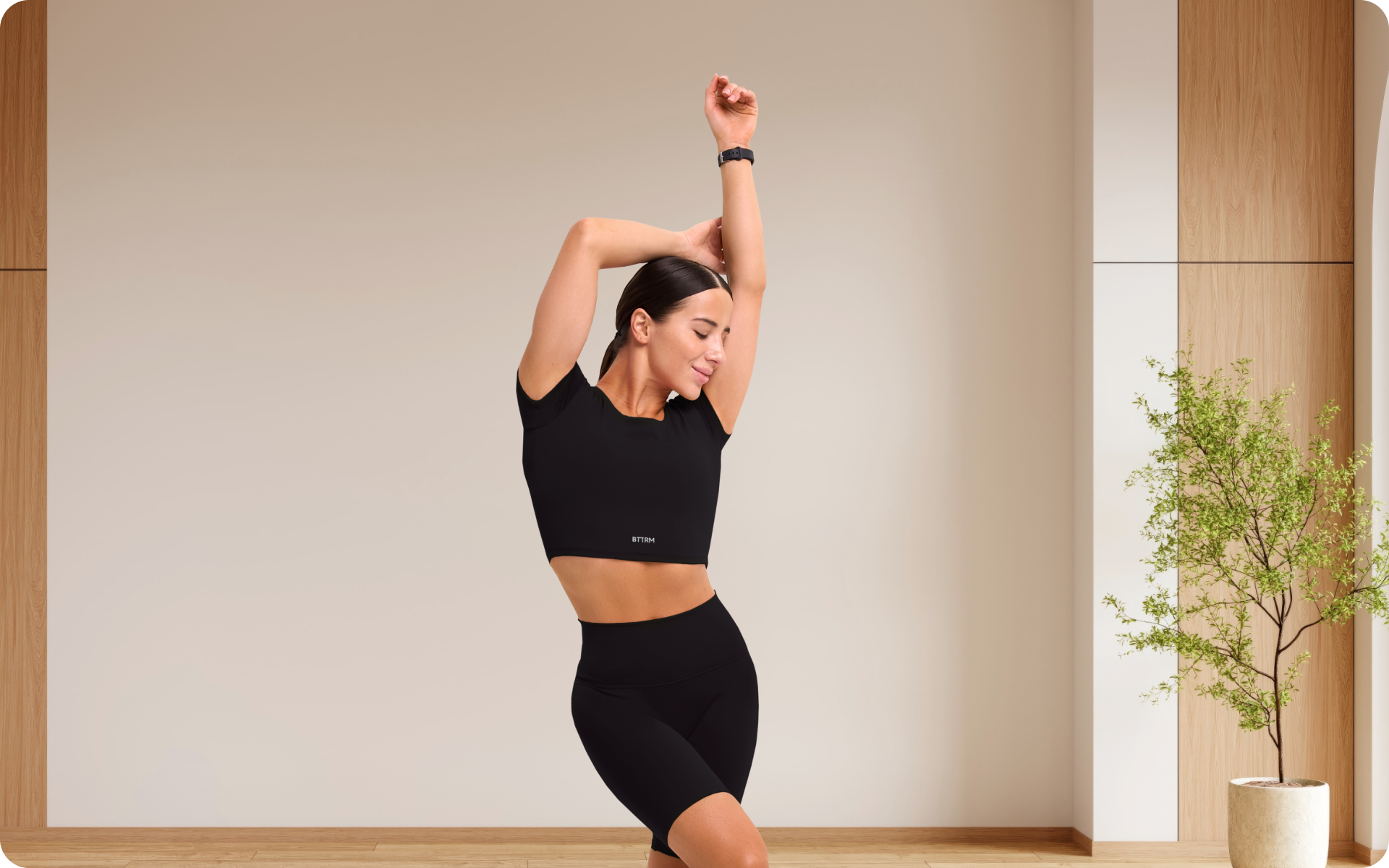You’ve probably seen it on your Instagram feed: toned bodies stretching gracefully, a calm instructor counting softly, and maybe a fancy Reformer machine in the background. Pilates has that reputation of being classy and sophisticated.
Many view the practice and assume it is something that not everyone can do. But here’s a little secret: You don’t need a machine (or a celeb trainer) to get started with Pilates practice.
Meet Mat Pilates.
It’s a no-nonsense, all-benefit version of this powerhouse workout. By using only a mat and your body weight, you can:
- Ease back pain
- Boost flexibility
- Improve posture
- Build core strength
- All while staying low-impact and joint-friendly (1).
Mat Pilates can help build a strong foundation (2), whether you’re new to fitness or looking to deepen your body awareness. It’s simple, accessible, and surprisingly challenging. Are you ready to feel stronger, more mobile, and more balanced?
Let’s roll out our mats and get started!
What Is The Secret Behind Pilates Mat Exercises For Toning?
Pilates mat exercises help tone the body by combining bodyweight resistance and enhancing muscle engagement (3). Although the term “toning” isn’t scientific, most fitness experts use the word to describe a firmer, more defined appearance.
Typically, toned individuals feature lean muscle and less body fat.
Pilates Mat exercises can help you get there through:
- Eccentric muscle contractions: These are movements where the muscle lengthens under tension (like the downward portion of a bicep curl ). Research shows that they can effectively strengthen muscles and enhance definition (4).
- Core-focused training: Pilates targets deep stabilizing muscles, particularly those in the core. This core focus can help improve posture and give the body a more lifted and aligned appearance (5).
Some of the best Pilates mat exercises can sharpen body awareness and coordination.
They may let you engage the right muscles more efficiently in workouts and daily movements (6). This muscle engagement can make your entire body feel (and appear) stronger and more balanced.
Whether you’re a workout beast or just a beginner making your first foray into the world of fitness and dieting – BetterMe has a lot to offer to both newbies and experts! Install the app and experience the versatility first-hand!
That said, visible muscle tone depends on a combination of factors.
Although Pilates builds muscle endurance and control, it doesn’t offer the progressive overload needed for significant hypertrophy. And it isn’t a major fat-burning workout on its own. For the best “toning” results, combine Pilates with cardio and a balanced diet.
Still, Pilates excels in one key area: mobility.
It forces the body to work through different ranges of motion, which can help to improve the body’s mobility over time. It’s low-impact, sustainable, and enjoyable. All of which keep you coming back for more!
Read more: Wall Pilates for Weight Loss: Does It Work?
Is Mat Pilates Good Exercise?
Pilates has consistently proven its effectiveness. Below, we take a look at some of the perks that tag along with regular Pilates practice:
- May Enhance Core Strength
Pilates is well-known for its focus on the core.
The muscles in your midsection support nearly every move you make, including those around your stomach, lower back, and hips. When your core is strong, it can stabilize and support your entire body (7).
Strengthening your core through Pilates can improve your body’s function.
It may help ease back and hip pain, improve pelvic floor health, and make everyday movements feel easier.
- May Boost Energy Levels
Pilates puts a strong emphasis on mindful breathing.
It can help improve your heart and lung function over time. This deep, controlled breathing boosts oxygen flow, supports better blood circulation, and even helps release feel-good hormones, such as endorphins (8).
Because Pilates is low-impact and gentle on the joints, it doesn’t leave you feeling drained. Instead, it often leaves you feeling refreshed and more in tune with your body.
- May Enhance Body Awareness
Pilates mat exercises for beginners do more than just build strength.
They also help improve body awareness. This type of mind-body workout encourages you to focus on how your body moves and feels during each exercise.
That awareness, also known as proprioception, helps you better understand your posture, balance, and how your body responds to movement (9).
As you practice floor mat exercises regularly, you become more in tune with your body’s signals, like when something feels off or you’re holding unnecessary tension.
This improved awareness can reduce your risk of injuries or falls by helping you react more quickly and move more mindfully (10).
- May Make You Feel Better
Even when doing Pilates exercises for beginners on a mat, you can expect a positive impact on your overall well-being.
A 2018 study in Complementary Therapies in Medicine found that regular Pilates sessions significantly improved mental well-being and reduced anxiety levels (11).
The focus on breath and movement creates a calming effect, making you feel more balanced and refreshed.
- May Contribute To Fat Burn
Mat exercises for abs in Pilates can activate not only the deep core muscles but also other major muscles of the body. This comprehensive, full-body workout can result in a high calorie burn, and when paired with a healthy diet in a calorie deficit, can lead to significant fat loss.
Although Pilates isn’t a high-intensity cardio workout, its consistent practice can increase muscle endurance and improve body composition (12). When combined with a healthy diet and regular exercise, mat exercises can contribute to a leaner and firmer midsection.
Apart from the ones listed here, you can experience many other benefits when you start doing Mat Pilates. Some of these are similar to the regular exercise perks, while others are specific to Pilates. For example, some people may experience better posture and reduced lower back pain after starting to do mat Pilates.
Ultimately, the beauty of Mat Pilates lies in its ability to strengthen both the body and mind. They offer lasting benefits that go far beyond the mat!
Which Is Better, Yoga Or Mat Pilates?
Both yoga and mat Pilates offer impressive benefits for improving strength, flexibility, and well-being. However, each provides these perks in slightly different ways.
Choosing between the two exercises depends on your goals, preferences, and what you enjoy most in a workout.
Here’s a quick comparison chart to help you decide:
Yoga might be the better choice if you’re seeking stress relief and improved flexibility.
In contrast, mat Pilates can help build core strength and improve posture.
Some people even enjoy combining both for a well-rounded routine. The best workout is the one you’ll stick to and enjoy.
Can I Lose Weight Doing Mat Pilates?
Yes, you can lose weight doing mat Pilates. However, it’s not a magic fix.
Instead of torching calories like a spin class or a long run, Pilates works more subtly (and sustainably).
For example, Pilates mat exercises with rings add extra resistance.
They allow you to engage more muscle groups in your core, arms, and thighs.
This muscle engagement challenge helps build lean muscle while also slightly boosting your resting metabolism (15). It means your body burns more calories even when you’re not exercising.
Reasons why BetterMe is a safe bet: a wide range of calorie-blasting workouts, finger-licking recipes, 24/7 support, challenges that’ll keep you on your best game, and that just scratches the surface! Start using our app and watch the magic happen.
Note that Pilates alone can’t help you shed calories, but it’s a powerful tool when you combine it with:
- Cardio
- Strength training
- A balanced diet
Think of it as a solid foundation to tone, strengthen, and support your body (refer to the benefits discussed above).
It’s not a popular opinion, but most of us have this inherent feeling that we need to do better when we start feeling good about ourselves. By incorporating Pilates into your routine, you will likely become more conscious of your eating and sleeping habits.
Is 20 Minutes Of Mat Pilates Enough?
If done right, 20 minutes of mat Pilates can go a long way. Not everyone has the time or energy for hour-long workouts. The good news is that you don’t always need them to see results. For beginners, short, focused sessions can be both practical and sustainable.
A study published in the Journal of Sports Science & Medicine (2011) found that participants who practiced just 20 minutes of Pilates 3 times a week for 8 weeks significantly improved their flexibility, core strength, and posture (16).
That’s proof that quality matters more than quantity.
Pilates isn’t about burning out your muscles. It’s about mindful movement, control, and connecting breath with motion. If you’re following a well-structured Pilates mat exercises list or program for beginners, you still engage deep core muscles, improve mobility, and build strength.
Keep the following factors in mind:
- Stay consistent with your practice
- Focus on proper form and alignment.
- Gradually increase time or intensity when your body’s ready.
So, 20 minutes is enough to experience the benefits of Pilates. It’s not about how long you move, but how intentionally you do it. And let’s be honest: fitting in 20 minutes is a far better choice than skipping a workout altogether!
Read more: Pilates Weekly Workout Plan for Beginners
How Many Times A Week Should I Do Mat Pilates To See Results?
For most people, Mat Pilates 2-4 times a week is a solid way to start seeing results.
You’ll likely notice improvements in strength, posture, flexibility, and how in tune you feel with your body (17).
- If you’re new to Pilates practice, start with 2 sessions a week to ease into the movements.
- As you become more comfortable and your core strengthens, try working up to 3-4 sessions per week. It helps you stay consistent without overdoing it.
Even Joseph Pilates believed practicing at least 4 times a week brought the best results (18). But don’t stress about hitting that number right away. Finding a rhythm you can stick with over time is the most sustainable thing.
Yes, the way Mat Pilates can strengthen your core and improve flexibility is a vivid indication that it can help you get in shape. It doesn’t replace high-intensity cardio, but consistent practice, paired with a healthy diet, can significantly shape and tone your body. It depends on your goals. Mat Pilates is great for developing core strength, stability, and body awareness, while weightlifting is better suited for building muscle mass and increasing strength quickly (18). The best routine includes a mix of both! Go for something in between. A mat that’s too thick can throw off your balance, while a thin one might not give enough support (19). Select a mat that is approximately 1/2 inch thick for optimal comfort and control during your movements. The Teaser takes the crown! It challenges your balance, core strength, and control simultaneously. And it looks easier than it feels.Frequently Asked Questions
Can you get in shape with mat Pilates?
Is mat Pilates better than weight lifting?
Is a thick or thin mat better for Pilates?
What is the hardest Pilates move on the mat?
The Bottom Line
Mat Pilates may seem simple, but don’t underestimate its power. With just a mat and your bodyweight, you can build real strength, improve your posture, and feel more balanced, both physically and mentally.
It’s flexible, beginner-friendly, and surprisingly effective when done with intention and consistency. So, if you’ve been waiting for the “perfect” time to start, this is it.
Just roll out your mat and let Pilates meet you where you are.
DISCLAIMER:
This article is intended for general informational purposes only and does not serve to address individual circumstances. It is not a substitute for professional advice or help and should not be relied on for making any kind of decision-making. Any action taken as a direct or indirect result of the information in this article is entirely at your own risk and is your sole responsibility.
BetterMe, its content staff, and its medical advisors accept no responsibility for inaccuracies, errors, misstatements, inconsistencies, or omissions and specifically disclaim any liability, loss or risk, personal, professional or otherwise, which may be incurred as a consequence, directly or indirectly, of the use and/or application of any content.
You should always seek the advice of your physician or other qualified health provider with any questions you may have regarding a medical condition or your specific situation. Never disregard professional medical advice or delay seeking it because of BetterMe content. If you suspect or think you may have a medical emergency, call your doctor.
SOURCES:
- Exercise therapy for chronic low back pain (2012, cochranelibrary.com)
- The Science of Pilates Research (2021, ideafit.com)
- Pilates for Improvement of Muscle Endurance, Flexibility, Balance, and Posture (2010, journals.lww.com)
- Loading Recommendations for Muscle Strength, Hypertrophy, and Local Endurance: A Re-Examination of the Repetition Continuum (2021, mdpi.com)
- Pilates: how does it work and who needs it? (2011, pmc.ncbi.nlm.nih.gov)
- Pilates Based Exercise in Muscle Disbalances Prevention and Treatment of Sports Injuries (2011, intechopen.com)
- Core Stability (n.d., physio-pedia.com)
- Pilates Method Improves Cardiorespiratory Fitness: A Systematic Review and Meta-Analysis (2019, pmc.ncbi.nlm.nih.gov)
- Proprioception (n.d., sciencedirect.com)
- Education in the Age of Anxiety- The Impact of Mindfulness Activities on First-Year College Students (2023, researchgate.net)
- Effects of Pilates on health and well-being of women: a systematic review (2023, bfpt.springeropen.com)
- The effect of Pilates exercises on body composition: A systematic review (2012, bodyworkmovementtherapies.com)
- Effects of yogic breath regulation: A narrative review of scientific evidence (2019, sciencedirect.com)
- 9 Benefits of Yoga (n.d., hopkinsmedicine.org)
- Efficacy of Pilates in Functional Body Composition: A Systematic Review (2022, mdpi.com)
- The Effect of Mat Pilates Exercise Program on Body Mass Index and Body Composition in Non-Physically Active Working Iraqi Women (2022, sportsmedoa.com)
- How Long to See Results from Pilates (2023, mdhealth.com.au)
- Is pilates better than other exercises at increasing muscle strength? A systematic review (2022, researchgate.net)
- The Yoga Mat (2017, researchgate.net)
